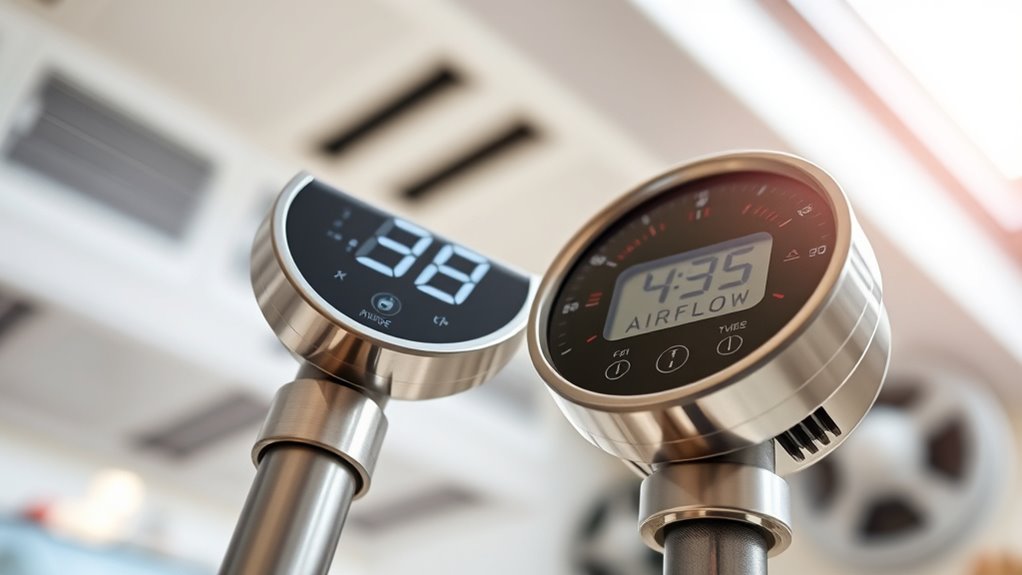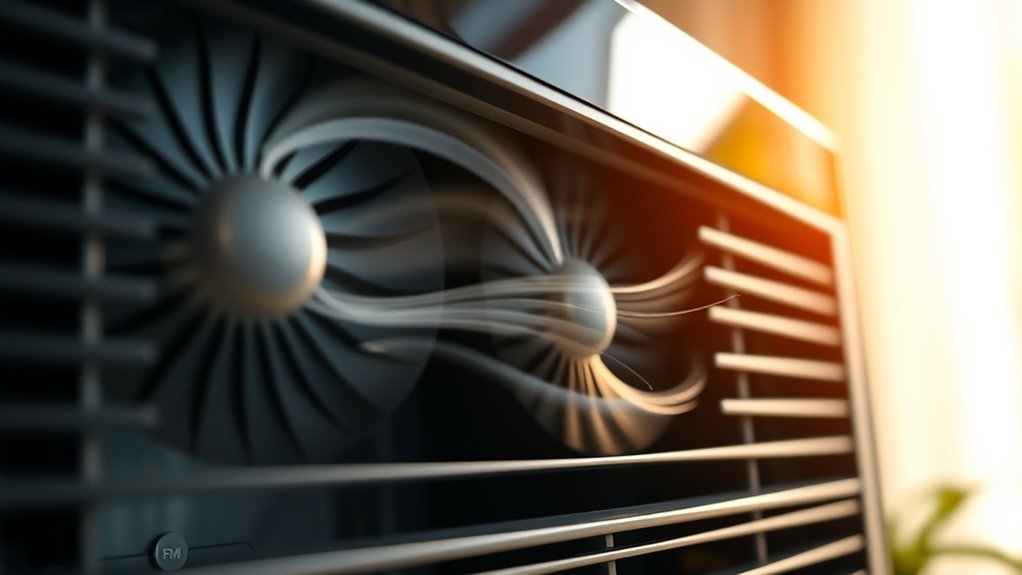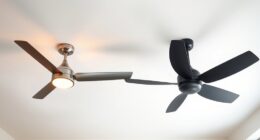CFM (cubic feet per minute) measures how much air a fan or blower moves in a minute, making it essential for evaluating airflow capacity and system performance. It helps you understand whether a device can meet your ventilation or cooling needs, but keep in mind that actual airflow depends on static pressure and ambient conditions. Higher CFM generally means more airflow, but factors like system resistance influence real-world performance. Exploring these details will give you a clearer picture of airflow ratings.
Key Takeaways
- CFM measures the volume of air moved per minute by a fan or blower under standardized conditions.
- It indicates airflow capacity but does not account for system resistance or static pressure.
- Higher CFM generally means greater airflow, but actual performance depends on system resistance.
- CFM ratings are measured under specific test conditions, which may vary from real-world environments.
- Balancing CFM with static pressure and power consumption ensures optimal airflow and system efficiency.

Understanding CFM (Cubic Feet per Minute) is essential for evaluating the performance of air-moving devices such as fans and blowers. It quantifies the volume of air an apparatus moves within a minute, serving as a critical parameter for assessing efficiency and suitability for specific applications. When analyzing a device’s CFM rating, you need to recognize that it reflects the volumetric flow rate under standardized conditions, but real-world performance can vary based on system resistance, ducting, and environmental factors. Consequently, a thorough understanding of CFM involves not only reading the rating but also contextualizing it within your operational environment.
The CFM metric provides a direct measure of airflow capacity, but it does not account for pressure differential or static pressure resistance encountered in the system. For instance, a high CFM rating indicates a significant volume of air being moved, yet if the system has high static pressure, the actual airflow will decrease despite the rated CFM. Conversely, a device with a lower CFM may perform adequately in low-resistance environments but underperform when system constraints increase. As you compare fans or blowers, it is important to consider both the CFM and the static pressure capabilities, often expressed as static pressure ratings in inches of water column (inH₂O). This dual consideration helps you determine whether a device can maintain its airflow rate against the expected resistance.
Another factor to keep in mind is the relationship between CFM and power consumption. Higher airflow rates generally require more energy, which impacts operational costs and energy efficiency. When selecting equipment, you should analyze the CFM rating in conjunction with the device’s power specifications, such as wattage or motor horsepower, to guarantee you balance airflow needs with energy efficiency. Additionally, the conditions under which CFM is measured are significant. Standard testing often occurs at specific static pressures and ambient conditions, but actual performance can differ due to temperature, humidity, and system design. Recognizing these variables enables you to predict real-world airflow more accurately and avoid overestimating a device’s capacity.
Furthermore, understanding the performance ratings and how they relate to different operational environments can help you choose equipment that aligns with your specific needs. Lastly, understanding the application-specific implications of CFM is essential. For example, in ventilation systems, higher CFM ensures adequate air exchange, but excessive airflow can cause noise, energy waste, and system stress. Conversely, in precision environments like clean rooms or laboratories, maintaining controlled airflow with precise CFM ratings is critical to ensuring environmental stability. Therefore, evaluating CFM involves not only reading the rated airflow but also understanding how it interacts with system resistance, energy consumption, environmental variables, and application requirements. This analytical approach allows you to select the most appropriate air-moving device, optimizing performance while controlling costs and operational reliability.
Frequently Asked Questions
How Does CFM Affect Indoor Air Quality?
Higher CFM improves indoor air quality by increasing airflow, which helps dilute and remove airborne pollutants, allergens, and odors. When your ventilation system has an adequate CFM, it guarantees fresh air circulates effectively, reducing the concentration of contaminants. Conversely, low CFM can lead to stagnant air, buildup of pollutants, and poor air quality. You should select a system with CFM ratings appropriate for your space to optimize air cleanliness and health.
Can CFM Be Adjusted on Most Fans?
While many fans offer adjustable CFM settings, not all do. You can typically control airflow on ceiling fans with pull chains or remote controls, allowing you to increase or decrease CFM as needed. Conversely, some exhaust or ventilation fans have fixed settings, limiting customization. To enhance indoor air quality, select fans with adjustable CFM that suit your space, ensuring precise control over airflow rates for ideal comfort and efficiency.
Is Higher CFM Always Better for Ventilation?
Higher CFM isn’t always better for ventilation because it depends on your specific space’s needs. Excessive airflow can cause noise, energy waste, and uneven air distribution, reducing efficiency. Conversely, insufficient CFM fails to provide proper ventilation, risking poor air quality. You should select a fan with a CFM rating tailored to your room’s size and purpose, optimizing ventilation without unnecessary energy consumption or noise.
How Does Room Size Influence Ideal CFM?
Room size acts like the anchor in your ventilation calculations, directly influencing the ideal CFM. Larger rooms require higher airflow to maintain air quality, typically calculated by multiplying volume by recommended air changes per hour. For example, a 300 sq ft room with 8-ft ceilings needs around 20-30 CFM. Precise calculations prevent under- or over-ventilating, ensuring efficient air exchange tailored to your space’s dimensions.
What Are the Safety Considerations With High CFM Fans?
High CFM fans can pose safety risks if not properly managed. You should guarantee adequate ventilation to prevent excessive airflow, which can cause drafts or dehydration. Avoid placing powerful fans near sensitive equipment or fragile materials that could be displaced or damaged. Regularly inspect fan blades and wiring for wear, and use appropriate safety guards to prevent accidental contact. Properly sizing and positioning fans minimizes risks while optimizing airflow efficiency.
Conclusion
So, now you know CFM measures airflow, and higher ratings don’t automatically mean better performance—unless you enjoy unnecessary noise and energy waste. Remember, more isn’t always better; it’s about matching airflow to your specific needs. Overestimating CFM can lead to inefficiency and frustration, proving that precise calculations trump blind assumptions. In the end, understanding CFM isn’t just technical; it’s your secret weapon against misguided choices in ventilation. Who knew airflow could be so enlightening?








